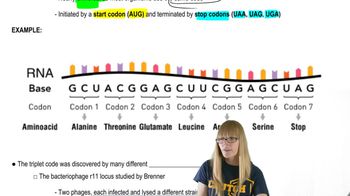Table of contents
- 1. Introduction to Genetics51m
- 2. Mendel's Laws of Inheritance3h 37m
- 3. Extensions to Mendelian Inheritance2h 41m
- 4. Genetic Mapping and Linkage2h 28m
- 5. Genetics of Bacteria and Viruses1h 21m
- 6. Chromosomal Variation1h 48m
- 7. DNA and Chromosome Structure56m
- 8. DNA Replication1h 10m
- 9. Mitosis and Meiosis1h 34m
- 10. Transcription1h 0m
- 11. Translation58m
- 12. Gene Regulation in Prokaryotes1h 19m
- 13. Gene Regulation in Eukaryotes44m
- 14. Genetic Control of Development44m
- 15. Genomes and Genomics1h 50m
- 16. Transposable Elements47m
- 17. Mutation, Repair, and Recombination1h 6m
- 18. Molecular Genetic Tools19m
- 19. Cancer Genetics29m
- 20. Quantitative Genetics1h 26m
- 21. Population Genetics50m
- 22. Evolutionary Genetics29m
17. Mutation, Repair, and Recombination
Types of Mutations
Problem 9b
Textbook Question
Textbook QuestionIn studies of the amino acid sequence of wild-type and mutant forms of tryptophan synthetase in E. coli, the following changes have been observed: Determine a set of triplet codes in which only a single-nucleotide change produces each amino acid change.
 Verified Solution
Verified SolutionThis video solution was recommended by our tutors as helpful for the problem above
Video duration:
1mPlay a video:
Was this helpful?
Key Concepts
Here are the essential concepts you must grasp in order to answer the question correctly.
Codons and Triplet Codes
Codons are sequences of three nucleotides in mRNA that correspond to specific amino acids during protein synthesis. Each triplet code, or codon, is crucial for determining the sequence of amino acids in a protein. Understanding how these codons relate to the genetic code is essential for analyzing mutations and their effects on protein structure.
Recommended video:
Guided course

The Genetic Code
Point Mutations
Point mutations are changes in a single nucleotide base pair in the DNA sequence. These mutations can lead to different amino acids being incorporated into a protein, potentially altering its function. Identifying how a single-nucleotide change can affect the resulting amino acid is key to understanding the relationship between genotype and phenotype.
Recommended video:
Guided course

Point Mutations
Amino Acid Properties
Amino acids have distinct properties that influence protein structure and function. Changes in the amino acid sequence due to mutations can affect the protein's stability, activity, and interactions with other molecules. Recognizing how different amino acids can impact the overall behavior of proteins is vital for interpreting the effects of mutations in tryptophan synthetase.
Recommended video:
Guided course

Proteins

 9:49m
9:49mWatch next
Master Point Mutations with a bite sized video explanation from Kylia Goodner
Start learning


